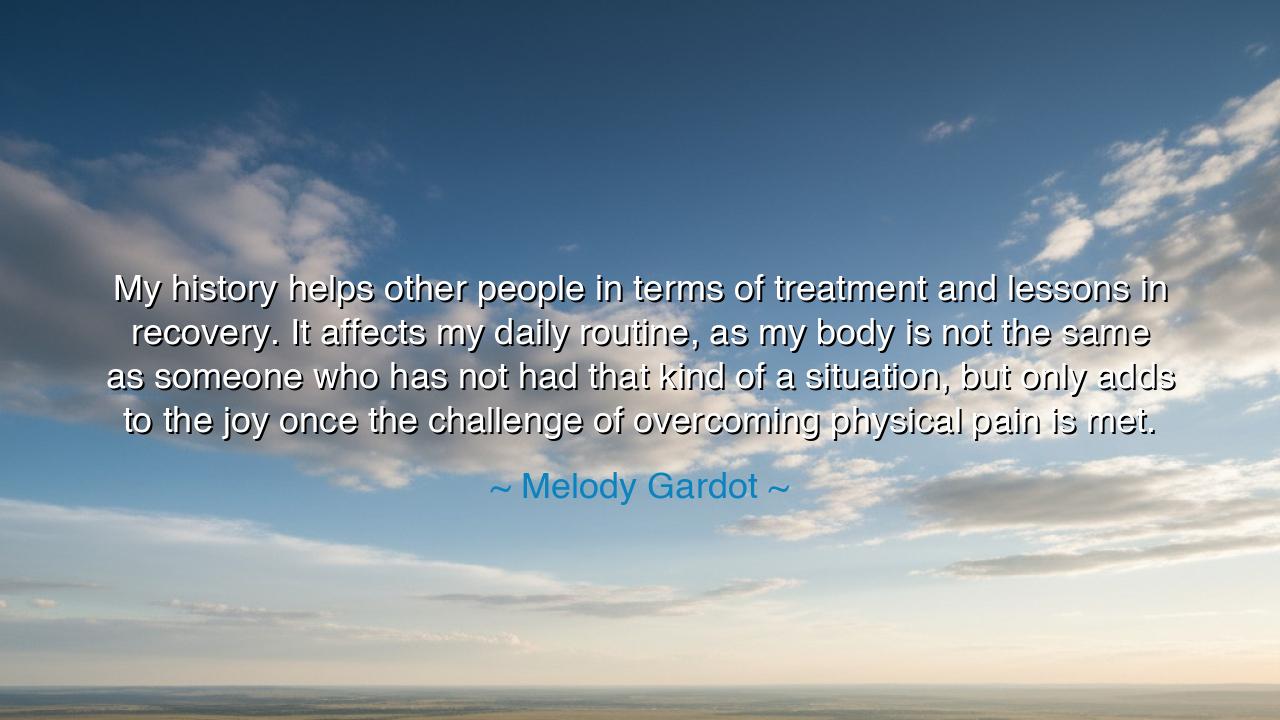
My history helps other people in terms of treatment and lessons
My history helps other people in terms of treatment and lessons in recovery. It affects my daily routine, as my body is not the same as someone who has not had that kind of a situation, but only adds to the joy once the challenge of overcoming physical pain is met.






“My history helps other people in terms of treatment and lessons in recovery. It affects my daily routine, as my body is not the same as someone who has not had that kind of a situation, but only adds to the joy once the challenge of overcoming physical pain is met.” Thus spoke Melody Gardot, the jazz singer and composer whose voice, smooth as moonlight and deep as sorrow, was born from suffering itself. Her words are not merely about endurance, but about transformation — the alchemy of pain into purpose, of limitation into liberation. In this reflection, Gardot teaches that the wounds of life, though they may scar the body, can sanctify the soul, and that through our trials, we gain not weakness but wisdom — a wisdom that can light the path for others who walk in darkness.
When Gardot speaks of her history, she refers to the ordeal that reshaped her life forever. In 2003, as a young woman full of promise, she was struck by a car while cycling. The crash left her with severe injuries — a fractured pelvis, spinal damage, and neurological trauma. For months she lay in darkness, unable to walk, struggling even to speak. Yet from that silence emerged a new music, a new identity. Through the power of sound and patience, she taught herself to live again. The songs she wrote in her convalescence — tender, soulful, and honest — were not only art, but medicine, healing her and all who heard her. Thus, when she says her history “helps other people,” she means that her recovery became a testament of hope, a living lesson that pain, when met with courage, becomes a teacher.
The origin of this quote lies in her philosophy of recovery as revelation. Gardot did not see her injuries as a prison, but as a passage — a crossing from the world of ease into the world of meaning. Her body, changed forever, became a map of both suffering and survival. Every routine task — every step, every breath — became a reminder of how fragile, yet sacred, life truly is. She could no longer move as freely as before, yet her spirit, paradoxically, moved more deeply. This paradox is the heart of her wisdom: that joy is magnified, not diminished, by the presence of pain, because joy gained through struggle is a joy fully understood.
Throughout the annals of time, this truth has echoed in the lives of many. Consider the story of Helen Keller, born blind and deaf, yet who through patience and perseverance came to touch the hearts of millions. She once said, “Character cannot be developed in ease and quiet. Only through experience of trial and suffering can the soul be strengthened.” Like Gardot, she turned her affliction into guidance for others, teaching that adversity is not the end of life but the awakening of its truest form. Or recall Frida Kahlo, who painted her pain into vibrant canvases that spoke of endurance and identity. These women, like Gardot, transmuted agony into art, wound into wisdom, showing that human greatness often blooms in the soil of hardship.
Gardot’s reflection also contains a subtle triumph over despair. She does not deny that her body is different — “not the same as someone who has not had that kind of situation” — but she embraces it as part of her identity. Her difference becomes not a deficit, but a source of depth. The body, once broken, now speaks a new language: one of empathy, patience, and strength. And when she says that this “adds to the joy,” she reveals a truth that few ever grasp — that true joy is not the absence of pain, but the victory over it. It is the laughter that comes after tears, the music that arises from silence, the sunrise seen only after a long night of endurance.
Her words remind us that the journey of healing is not only physical but spiritual. To recover is to rediscover, to rebuild not only the body but the meaning of one’s existence. Gardot’s story teaches that we do not return to who we were before suffering — we become something greater, something forged by fire. And in sharing our struggles openly, as she does, we become healers to others, offering them proof that their own pain is survivable, even transformable. What was once weakness becomes a bridge — between suffering and strength, between isolation and solidarity.
So let this lesson be passed down, like a sacred hymn of resilience: do not despise your wounds. They are not marks of failure, but signs that you have lived, endured, and learned. When you meet pain, meet it not with bitterness, but with curiosity — for hidden within it lies your rebirth. Let your struggles refine you as the flame refines gold. Like Melody Gardot, use your scars as instruments of compassion, your trials as tools of healing. Sing your truth, even if your voice trembles. For in the act of overcoming, you become both artist and teacher, and your life becomes the most beautiful melody of all — the song of a soul that has known pain, conquered it, and chosen joy nonetheless.






AAdministratorAdministrator
Welcome, honored guests. Please leave a comment, we will respond soon